Finite Element Analysis of Geogrid-Incorporated Flexible Pavement with Soft Subgrade
Abstract
1. Introduction
2. Research Approach and Numerical Simulation
2.1. Model Description
2.2. Load Application
2.3. Mesh and Boundary
2.4. Model Validation
2.5. Research Plan
3. Results
3.1. Geogrid Strain
3.2. Tensile Force in the Geogrid
3.3. Strain and Stress at the Subgrade
3.3.1. Vertical Stain
3.3.2. Plastic Strain and Shear Strain
3.4. Vertical Stress and Displacement at the Top of the Subgrade
4. Conclusions
- Geogrid significantly enhances the overall performance of flexible pavement by effectively managing tensile strain under traffic loads. It demonstrates notable tensile strain in proximity to the loading area while exhibiting minimal compressive strain at the central section.
- Geogrid significantly decreases the vertical strain exerted at the top of the subgrade. By incorporating geogrid, a noticeable decrease of approximately 36–38% in the maximum vertical strain is evident when compared to pavement without reinforcement.
- As the CBR value rises, vertical strain diminishes, though the zone of influence extends to a depth of 300 mm within the subgrade, beyond which strain variations are insignificant. At the subgrade’s surface, vertical strain decreases by approximately 17%, 39%, and 49% as the CBR value escalates from 1% to 3%, 5%, and 8%, respectively.
- The plastic strain observed in geogrid-incorporated pavement suggests that the elastic strain resulting from stress is comparatively minor. This implies that the presence of the geogrid layer has a more significant impact on the development of plastic strains than on resilient strains.
- Overall, this study shows the effectiveness of geogrid incorporation in flexible pavement and the role of geogrid in reducing the total stress, strain, and deflection of the pavement. However, further studies need to be carried out with different traffic loads to identify specific layer thicknesses for weak soil subgrade.
Author Contributions
Funding
Institutional Review Board Statement
Informed Consent Statement
Data Availability Statement
Conflicts of Interest
References
- Ziegler, M. Application of Geogrid Reinforced Constructions: History, Recent and Future Developments. Procedia Eng. 2017, 172, 42–51. [Google Scholar] [CrossRef]
- Zornberg, J.G. Functions and Applications of Geosynthetics in Roadways. Procedia Eng. 2017, 189, 298–306. [Google Scholar] [CrossRef]
- Abu-Farsakh, M.Y.; Chen, Q. Evaluation of geogrid base reinforcement in flexible pavement using cyclic plate load testing. Int. J. Pavement Eng. 2011, 12, 275–288. [Google Scholar] [CrossRef]
- Gong, H.; Sun, Y.; Huang, B. Gradient Boosted Models for Enhancing Fatigue Cracking Prediction in Mechanistic-Empirical Pavement Design Guide. J. Transp. Eng. Part B Pavements 2019, 145, 04019014. [Google Scholar] [CrossRef]
- Visvanathan, A.; Velayudhan, S.; Mathew, S. Field Evaluation of Coir Geotextile Reinforced Subgrade for Low Volume Pavements. J. Nat. Fibers 2022, 19, 597–609. [Google Scholar] [CrossRef]
- Leonardi, G.; Suraci, F. A 3D-FE Model for the Rutting Prediction in Geogrid Reinforced Flexible Pavements. Sustainability 2022, 14, 3695. [Google Scholar] [CrossRef]
- Alimohammadi, H.; Zheng, J.; Schaefer, V.R.; Siekmeier, J.; Velasquez, R. Evaluation of geogrid reinforcement of flexible pavement performance: A review of large-scale laboratory studies. Transp. Geotech. 2021, 27, 100471. [Google Scholar] [CrossRef]
- Hatami, K.; Bathurst, R.J. Development and verification of a numerical model for the analysis of geosynthethic-reinforced soil segmental walls under working stress conditions. Can. Geotech. J. 2005, 42, 1066–1085. [Google Scholar] [CrossRef]
- Hatami, K.; Asce, M.; Bathurst, R.J. Numerical Model for Reinforced Soil Segmental Walls under Surcharge Loading. J. Geotech. Geoenviron. Eng. 2006, 132, 673–684. [Google Scholar] [CrossRef]
- Demir, A.; Yildiz, A.; Laman, M.; Ornek, M. Experimental and numerical analyses of circular footing on geogrid-reinforced granular fill underlain by soft clay. Acta Geotech 2014, 9, 711–723. [Google Scholar] [CrossRef]
- Mukherjee, S.; Kumar, L.; Choudhary, A.K.; Babu, G.L.S. Pullout resistance of inclined anchors embedded in geogrid reinforced sand. Geotext. Geomembr. 2021, 49, 1368–1379. [Google Scholar] [CrossRef]
- Mukherjee, S.; Sivakumar Babu, G.L. Three-dimensional numerical modeling of geogrid reinforced foundations. Comput. Geotech. 2023, 158, 105397. [Google Scholar] [CrossRef]
- Hussein, M.G.; Meguid, M.A. A three-dimensional finite element approach for modeling biaxial geogrid with application to geogrid-reinforced soils. Geotext. Geomembr. 2016, 44, 295–307. [Google Scholar] [CrossRef]
- Amirhosseini, I.; Toufigh, V.; Toufigh, M.M.; Ghazavi-Baghini, E. Three-Dimensional Modeling of Geogrid Pullout Test Using Finite-Element Method. Int. J. Geomech. 2022, 22, 04021297. [Google Scholar] [CrossRef]
- Indian Roads Congress. IRC: 37-2012, Guidelines for the Design of Flexible Pavements; Indian Roads Congress: New Delhi, India, 2012; pp. 1–104. [Google Scholar]
- Abdesssemed, M.; Kenai, S.; Bali, A. Experimental and numerical analysis of the behavior of an airport pavement reinforced by geogrids. Constr. Build. Mater. 2015, 94, 547–554. [Google Scholar] [CrossRef]
- IRC 37:2018; Guidelines for the Design of Flexible Pavements. Indian Roads Congress: New Delhi, India, 2018.
- Singh, A.K.; Sahoo, J.P. Analysis and design of two layered flexible pavement systems: A new mechanistic approach. Comput. Geotech. 2020, 117, 103238. [Google Scholar] [CrossRef]
- Liu, Z.; Gu, X.; Ren, H. Rutting prediction of asphalt pavement with semi-rigid base: Numerical modeling on laboratory to accelerated pavement testing. Constr. Build. Mater. 2023, 375, 130903. [Google Scholar] [CrossRef]



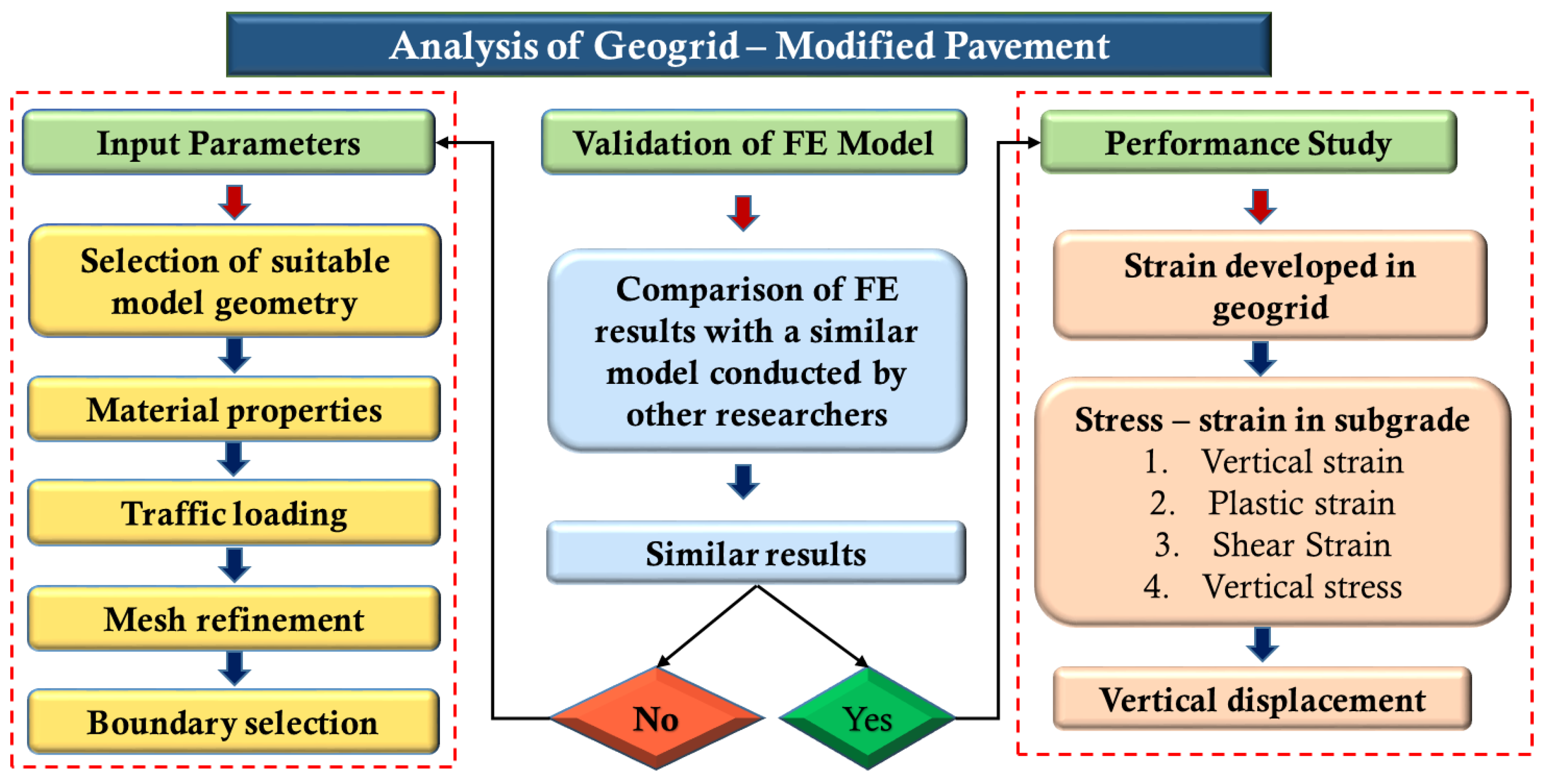


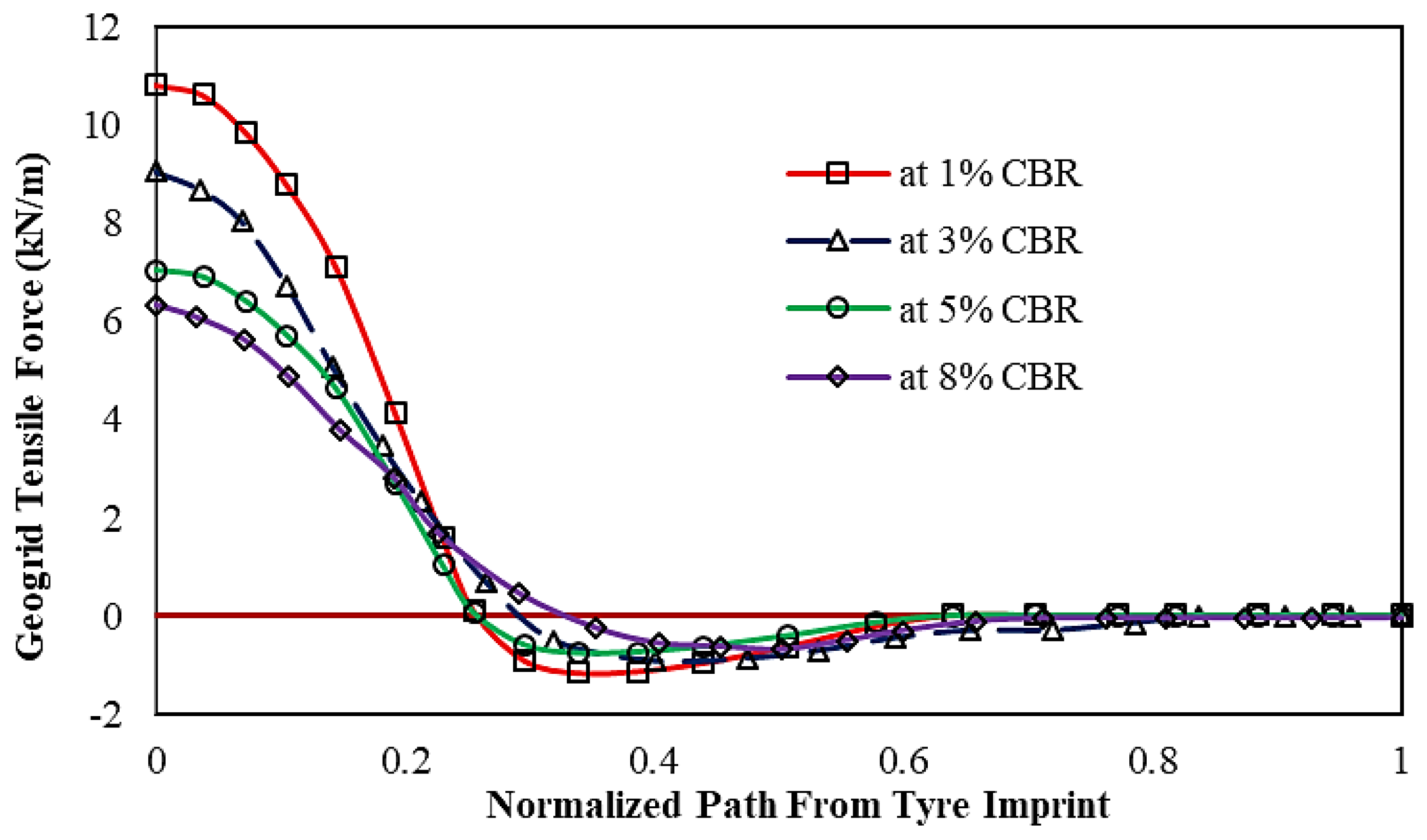
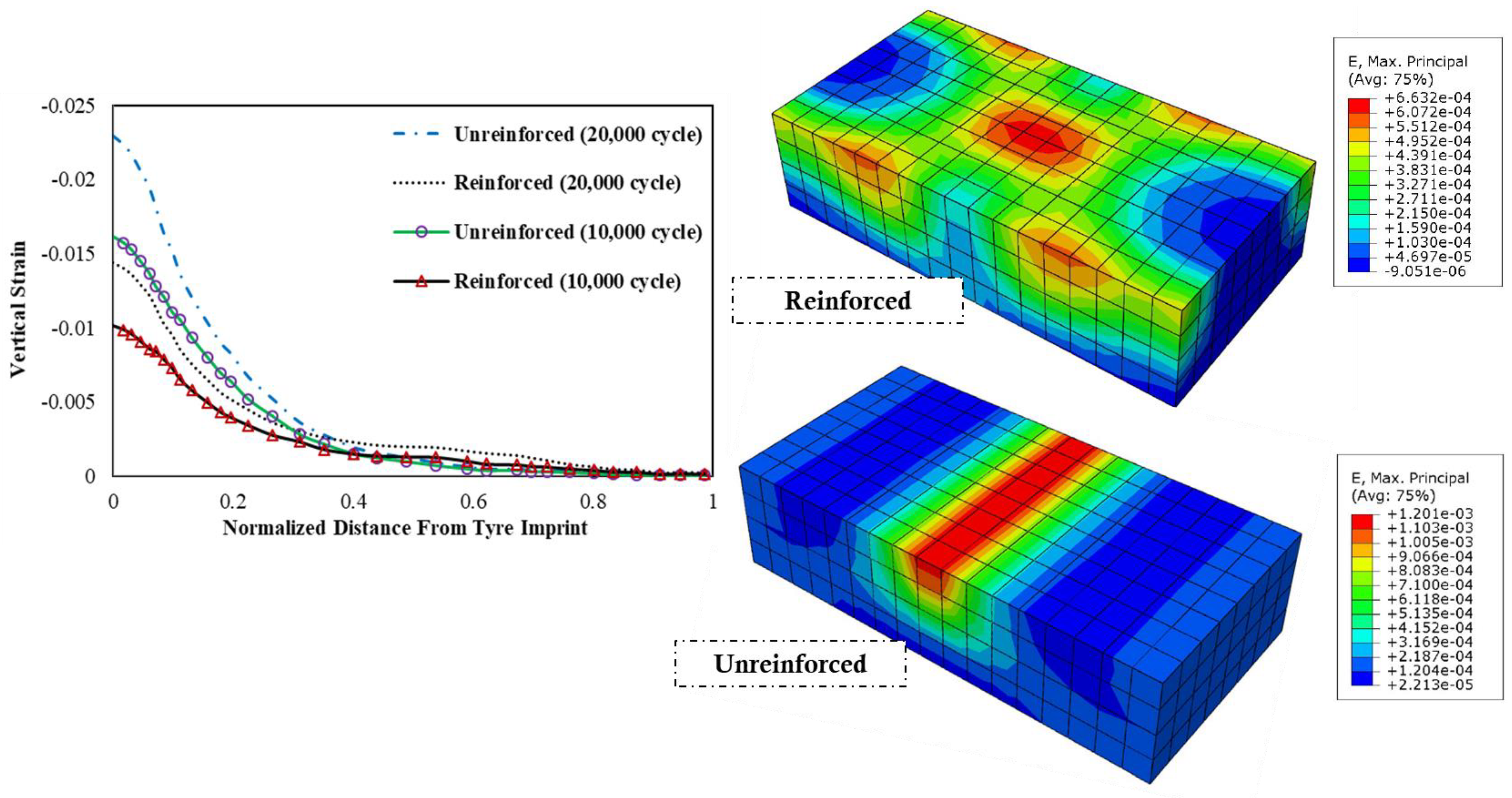
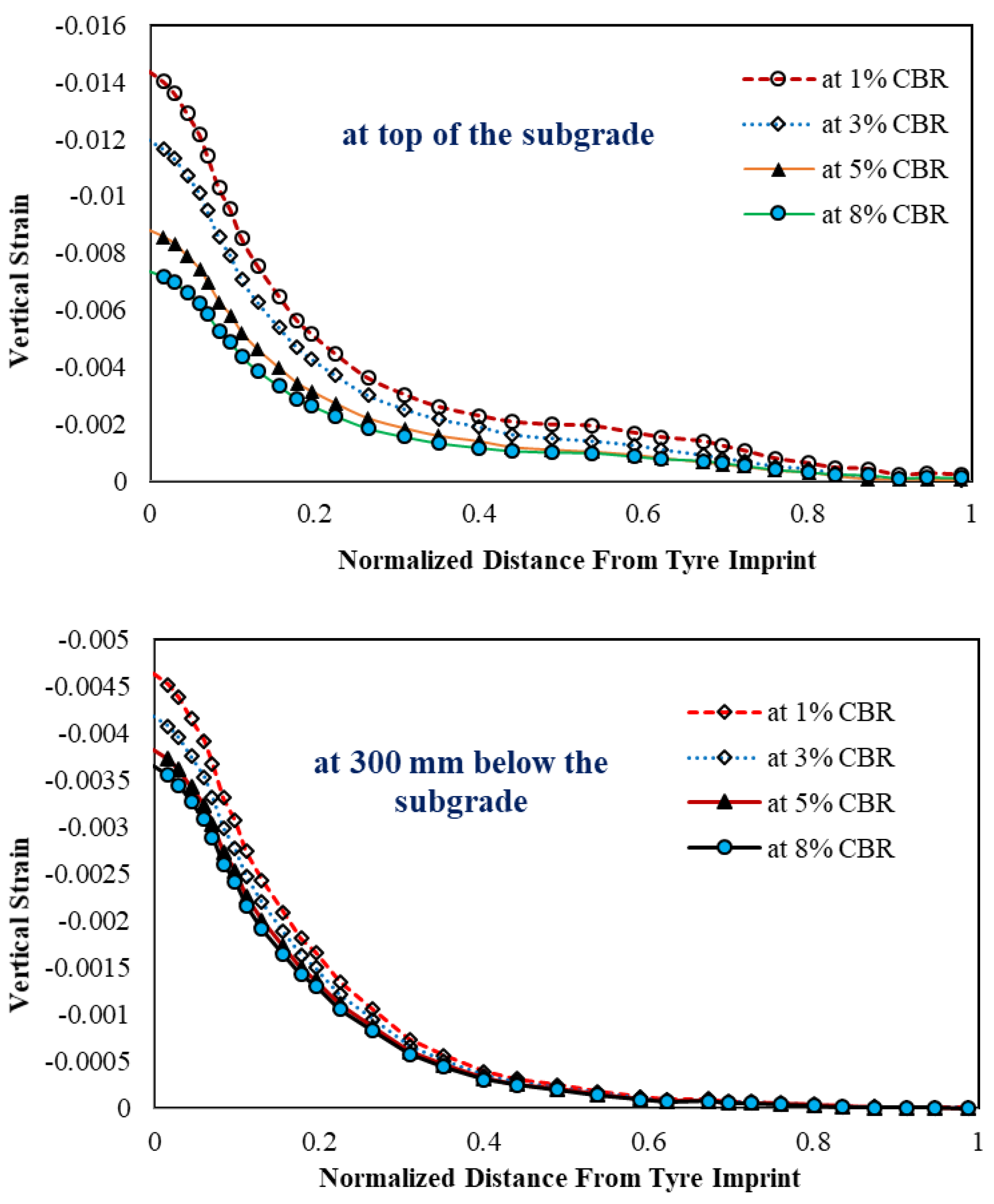
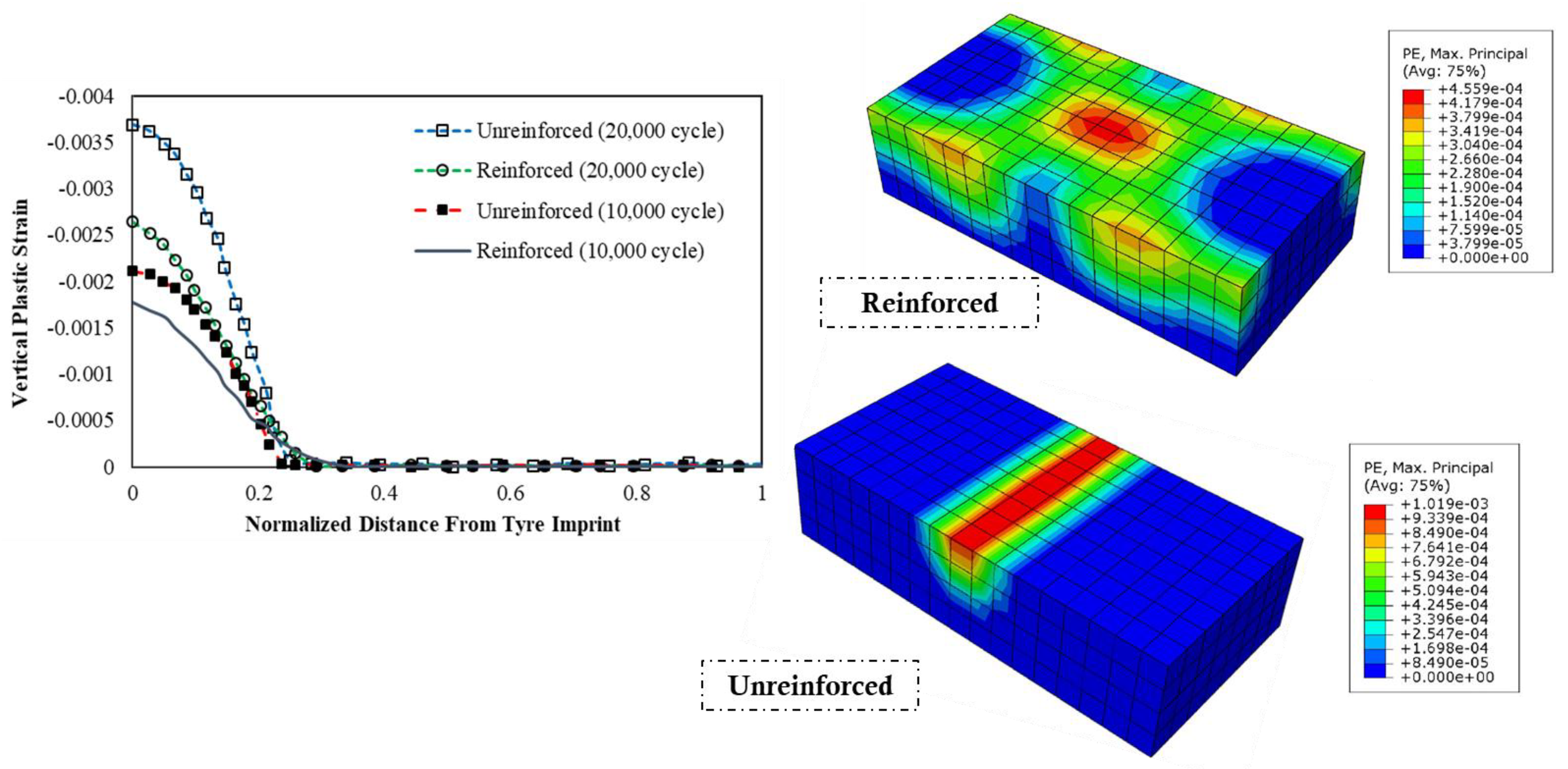

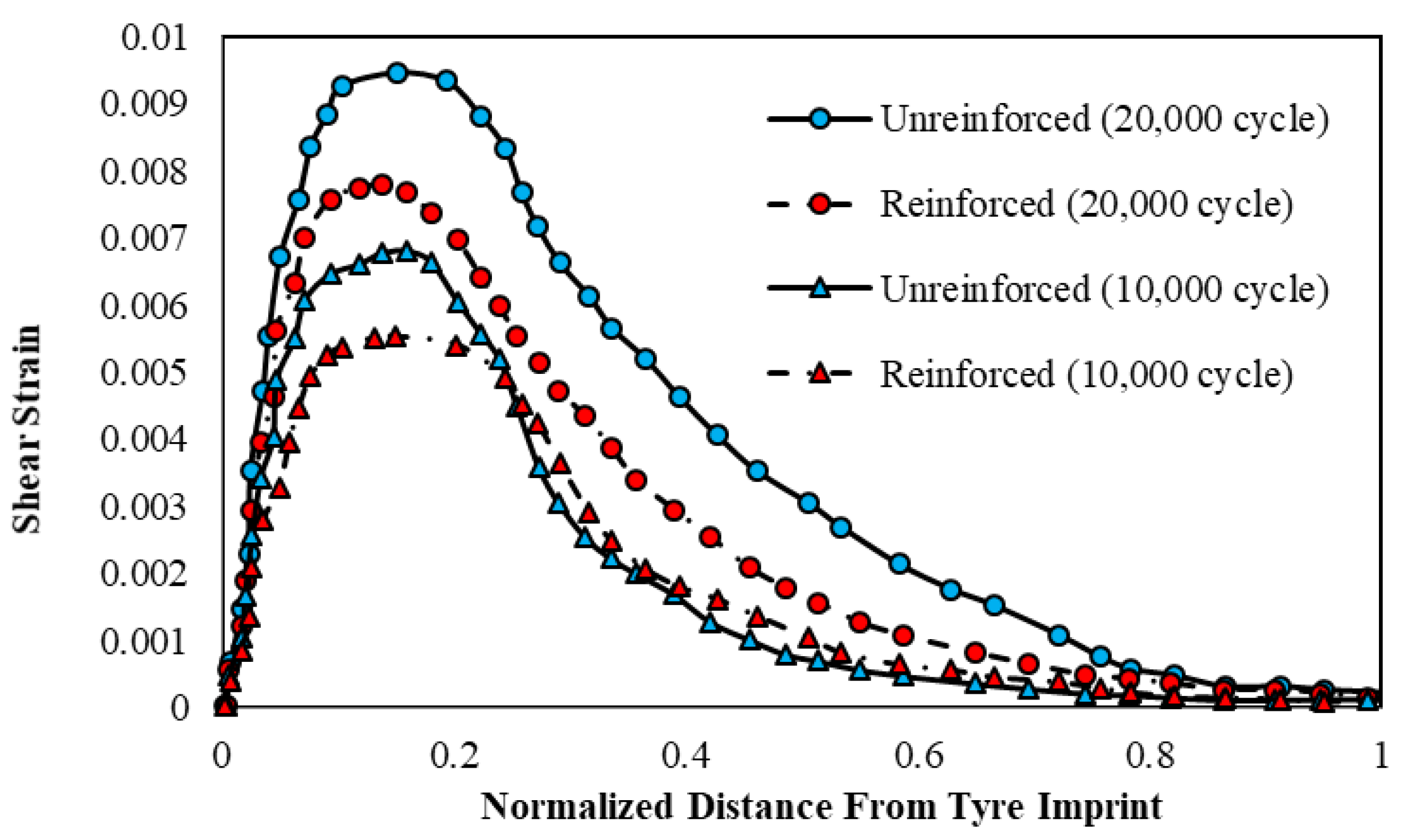

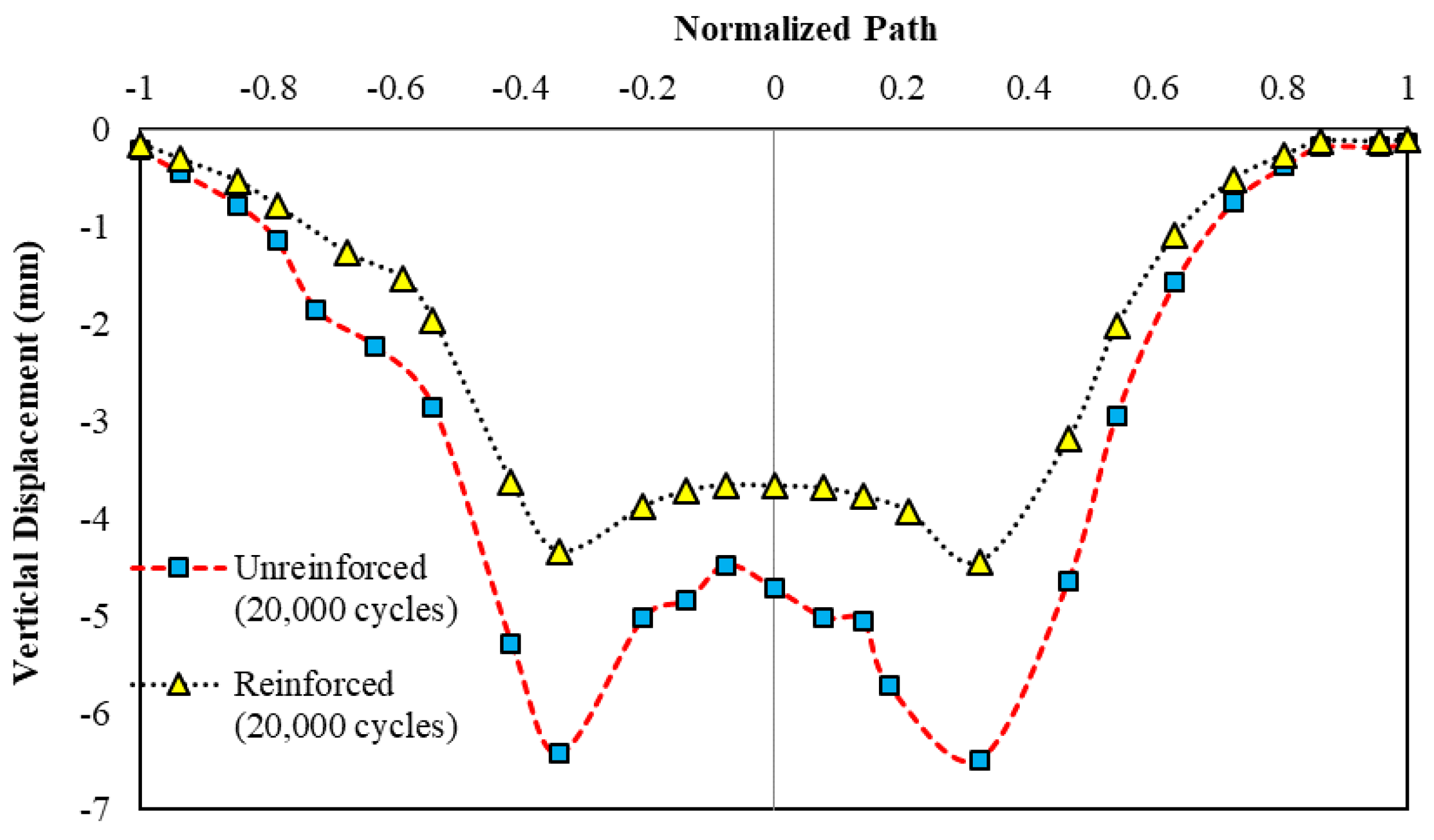
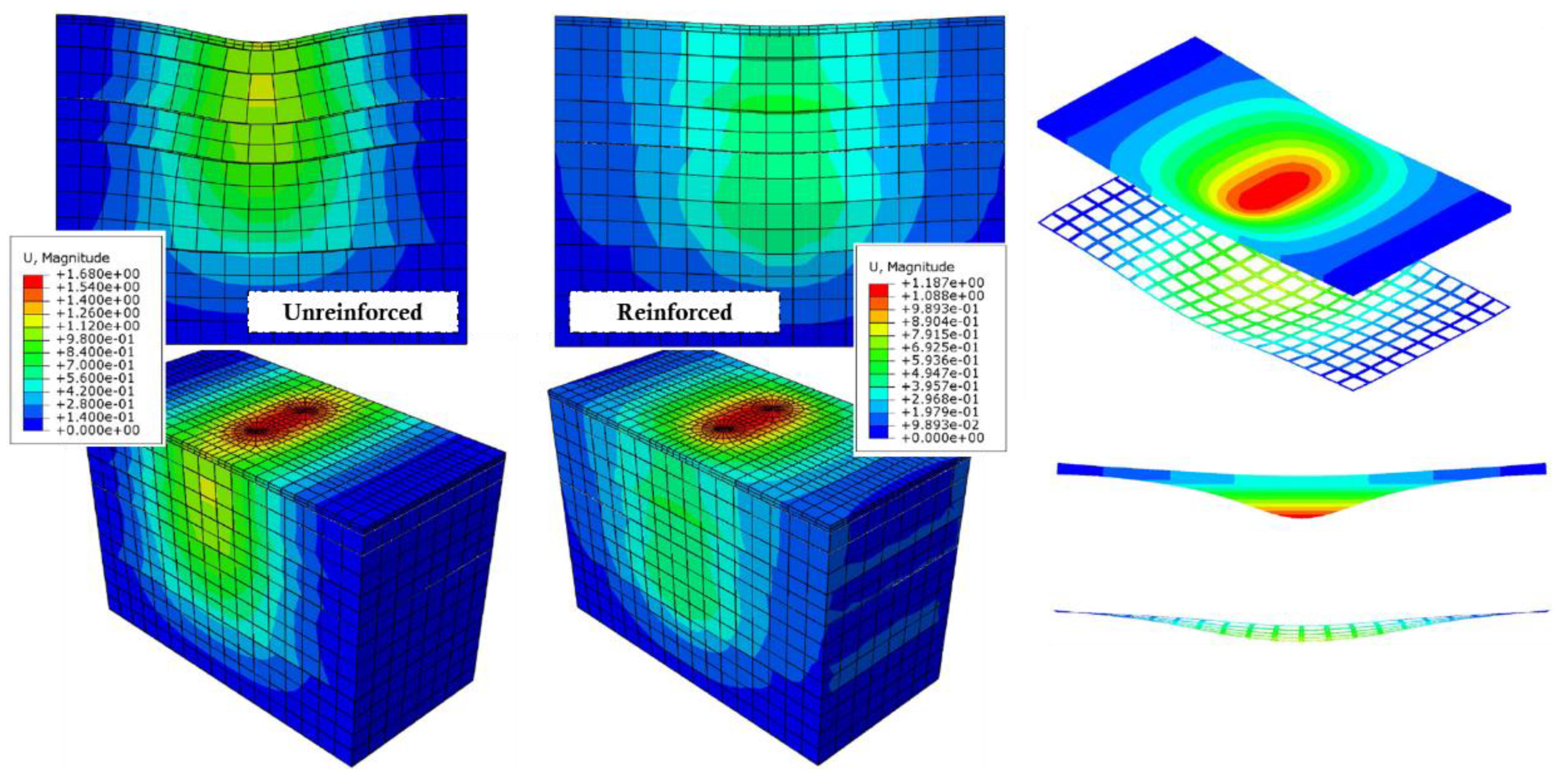
| Layers | E (MPa) | µ | (kg/m3) | C (MPa) | Ø (in Degree) | Element Type | Failure Criterion |
|---|---|---|---|---|---|---|---|
| Asphalt Concrete | 5400 | 0.4 | 2400 | - | - | C3D8R and C3D6 | LE |
| Binder Course | 5400 | 0.4 | 2500 | - | - | C3D8R | LE |
| Base Course | 1200 | 0.35 | 2200 | 10 | 40 | C3D8R | M-C |
| Sub-base Course | 1000 | 0.35 | 1800 | 10 | 40 | C3D8R | M-C |
| Subgrade | Variable | 0.35 | 1600 | 10 | 30 | C3D8R | M-C |
| Embankment | 400 | 0.3 | 1500 | 10 | 30 | C3D8R | M-C |
| Geogrid | 629.3 | 0.3 | 1100 | - | - | C3D6 | LE |
| Vertical Stress (kPa) at Subgrade’s Top | ||
|---|---|---|
| Base Course (BC) Thickness | Unreinforced | Reinforced |
| 150 | 267.5 | 233.7 |
| 180 | 229.3 | 204.4 |
| 220 | 197 | 181.9 |
| 250 | 175.4 | 163.5 |
Disclaimer/Publisher’s Note: The statements, opinions and data contained in all publications are solely those of the individual author(s) and contributor(s) and not of MDPI and/or the editor(s). MDPI and/or the editor(s) disclaim responsibility for any injury to people or property resulting from any ideas, methods, instructions or products referred to in the content. |
© 2024 by the authors. Licensee MDPI, Basel, Switzerland. This article is an open access article distributed under the terms and conditions of the Creative Commons Attribution (CC BY) license (https://creativecommons.org/licenses/by/4.0/).
Share and Cite
Chhetri, S.; Deb, P. Finite Element Analysis of Geogrid-Incorporated Flexible Pavement with Soft Subgrade. Appl. Sci. 2024, 14, 5798. https://doi.org/10.3390/app14135798
Chhetri S, Deb P. Finite Element Analysis of Geogrid-Incorporated Flexible Pavement with Soft Subgrade. Applied Sciences. 2024; 14(13):5798. https://doi.org/10.3390/app14135798
Chicago/Turabian StyleChhetri, Sagar, and Plaban Deb. 2024. "Finite Element Analysis of Geogrid-Incorporated Flexible Pavement with Soft Subgrade" Applied Sciences 14, no. 13: 5798. https://doi.org/10.3390/app14135798
APA StyleChhetri, S., & Deb, P. (2024). Finite Element Analysis of Geogrid-Incorporated Flexible Pavement with Soft Subgrade. Applied Sciences, 14(13), 5798. https://doi.org/10.3390/app14135798






